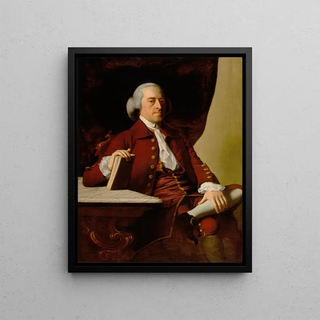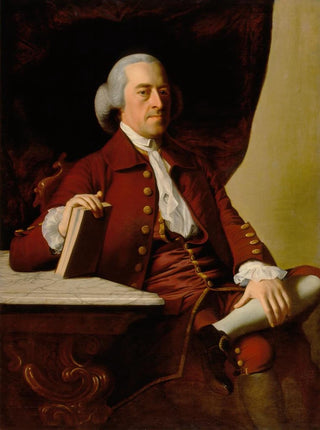Art print | Portrait of Joseph Scott - John Singleton Copley


View from behind

Frame (optional)
In the fascinating world of 18th-century painting, the "Art print of Joseph Scott" by John Singleton Copley stands out for its ability to capture not only the physical appearance of its subject but also their inner essence. This iconic work reflects a time when portraiture was a means of asserting social status and personality. As viewers contemplate this piece, they are transported to colonial Boston, a vibrant city brimming with intellectual and commercial activity. Copley, with his technical skill and keen sense of observation, manages to immortalize a moment in history while revealing the complexity of human character.
Style and uniqueness of the work
Copley's style is characterized by an impressive mastery of light and textures, elements that give his portraits a rare depth. In the "Art print of Joseph Scott," every detail, from the rich fabric of the coat to the subtle reflections in the eyes, is carefully crafted, creating an almost palpable illusion of life. The artist employs a palette of rich, nuanced colors that evoke an ambiance both warm and solemn. The poses of the figures are often thoughtfully chosen to suggest a certain dynamism, while maintaining a static dignity. This portrait is no exception; it exudes an aura of respectability and strength, while fitting into an artistic tradition that values individuality.
The artist and his influence
John Singleton Copley, an emblematic figure of American painting, transcended the boundaries of his era. Born in 1738 in Boston, he was influenced by European artistic currents while developing a style deeply rooted in his American context. Copley is often regarded as a pioneer of American portraiture, and his work has had a lasting influence on subsequent generations of artists. His portraits, such as that of Joseph Scott, go beyond simple representation; they are reflections on identity and social status during a time of political and cultural upheaval. The artist captured the spirit of his time while paving the way for a more personal and introspective approach to portraiture.
An exceptional wall decoration signed by Artem Legrand
In the context of a

Matte finish

View from behind

Frame (optional)
In the fascinating world of 18th-century painting, the "Art print of Joseph Scott" by John Singleton Copley stands out for its ability to capture not only the physical appearance of its subject but also their inner essence. This iconic work reflects a time when portraiture was a means of asserting social status and personality. As viewers contemplate this piece, they are transported to colonial Boston, a vibrant city brimming with intellectual and commercial activity. Copley, with his technical skill and keen sense of observation, manages to immortalize a moment in history while revealing the complexity of human character.
Style and uniqueness of the work
Copley's style is characterized by an impressive mastery of light and textures, elements that give his portraits a rare depth. In the "Art print of Joseph Scott," every detail, from the rich fabric of the coat to the subtle reflections in the eyes, is carefully crafted, creating an almost palpable illusion of life. The artist employs a palette of rich, nuanced colors that evoke an ambiance both warm and solemn. The poses of the figures are often thoughtfully chosen to suggest a certain dynamism, while maintaining a static dignity. This portrait is no exception; it exudes an aura of respectability and strength, while fitting into an artistic tradition that values individuality.
The artist and his influence
John Singleton Copley, an emblematic figure of American painting, transcended the boundaries of his era. Born in 1738 in Boston, he was influenced by European artistic currents while developing a style deeply rooted in his American context. Copley is often regarded as a pioneer of American portraiture, and his work has had a lasting influence on subsequent generations of artists. His portraits, such as that of Joseph Scott, go beyond simple representation; they are reflections on identity and social status during a time of political and cultural upheaval. The artist captured the spirit of his time while paving the way for a more personal and introspective approach to portraiture.
An exceptional wall decoration signed by Artem Legrand
In the context of a






